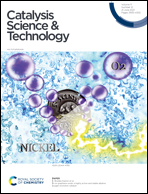Oxygen vacancy-engineered surfaces of ZnO-decorated porous BiOI microspheres for strongly enhanced visible-light NO oxidation†
Abstract
A central issue in understanding the photocatalytic oxidation of NOx on a defective hierarchical heterojunction interface is its adsorption mode and related reactivity. More than just enhancing the adsorption of NOx on heterojunction interfaces, it is demonstrated here that surface oxygen vacancies also present the possibility of activating NO and O2 toward improved photocatalytic oxidation of NO through a changed photocatalytic oxidation reaction pathway. Selecting the BiOI–ZnO heterojunction as a model system, we demonstrate that the dissociatively adsorbed NO on the oxygen vacancies of the heterojunction interface shows a higher tendency to be oxidized than molecularly adsorbed NO. The introduction of oxygen vacancies restrains the recombination of the photoexcited carriers and raises the quantum yield. This promotes the production of reactive oxygen species, leading to the dramatic promotion of visible-light photocatalytic oxidation of NO. These findings highlight the indispensable function of defective hierarchical heterojunction interface structures in the photocatalytic oxidation of NOx and may open up avenues for the rational design of highly efficient photocatalysts via surface engineering.



 Please wait while we load your content...
Please wait while we load your content...